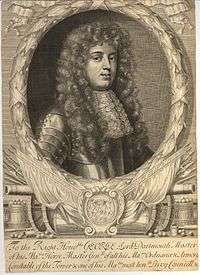George Legge, 1st Baron Dartmouth
| George Legge, 1st Baron Dartmouth | |
|---|---|
 George Legge, 1st Baron Dartmouth, by John Riley | |
| Spouse(s) | Barbara Archbold |
|
Issue
William Legge, 1st Earl of Dartmouth seven daughters | |
| Noble family | Legge |
| Father | William Legge |
| Mother | Elizabeth Washington |
| Born | c.1647 |
| Died |
25 October 1691 Tower of London |
| Buried | Holy Trinity, Minories, London |
Admiral George Legge, 1st Baron Dartmouth PC (c. 1647 – 1691) was an English naval commander who gave distinguished service to both Charles II and James II.
Biography
George Legge was the eldest son of the royalist Colonel William Legge by Elizabeth Washington (c.1616–1688). His maternal grandfather, Sir William Washington[1] (1590–1648), was the elder brother of Lawrence Washington, great-great grandfather of George Washington,[2] while his maternal grandmother, Anne Villiers, was a half-sister of James I's favourite, George Villiers, 1st Duke of Buckingham.
Naval career
Legge's naval career began in the Second Anglo-Dutch War of 1665–1667, where he served under his cousin Admiral Sir Edward Spragge; at the end of the war Legge was captain of HMS Pembroke. In March 1672, now in command of HMS Fairfax, he took part in the attack, on the Dutch Smyrna fleet lying off the Isle of Wight, that was the immediate cause of the Third Anglo-Dutch War. In June he fought in the Battle of Sole Bay. The following year he commanded HMS Royal Katherine under Prince Rupert of the Rhine in the Battle of Schooneveld.
By 1683 Legge had risen to be Admiral of the Fleet and he was sent out to Tangier to oversee the evacuation and destruction of the ill-fated English colony there. His last naval appointment was to the command of the Channel Fleet that unsuccessfully attempted to intercept the invasion force led by William III of Orange that landed in 1688 at the beginning of the Glorious Revolution.
Appointments and Honours

As a close supporter of the House of Stuart he held numerous royal appointments and honours.
- Lieutenant Governor of Portsmouth 1670
- Lieutenant-General of the Ordnance (obtained reversion 1672, succeeded 1679)
- Governor of Portsmouth 1673
- Master-General of the Ordnance 1682
- Master of the King's Horse 1685
- Constable of the Tower 1685
In 1682, he was elevated to the peerage by Charles II as the first Baron Dartmouth.
Death
Following the abdication of James II, Dartmouth was dismissed by the triumphant William III, and imprisoned in the Tower of London in July 1691. He died in the Tower a few months later, on 25 October,[3] without having been brought to trial, and was buried, as his father had been, in the church of the Holy Trinity, Minories, in London.[3]
He was succeeded as Baron Dartmouth by his only son, William Legge, 1st Earl of Dartmouth (1672–1750).
Marriage and issue
Dartmouth married, in November 1667, Barbara Archbold (1649/50–1718), the daughter of Sir Henry Archbold of Abbots Bromley, Staffordshire, by whom he had an only son, William Legge, 1st Earl of Dartmouth, born in 1672, and seven daughters.[3]
See also
Footnotes
References
- Davies, J.D. (2004). "Legge, George, first Baron Dartmouth (c.1647–1691)". Oxford Dictionary of National Biography (online ed.). Oxford University Press. doi:10.1093/ref:odnb/16352. (Subscription or UK public library membership required.) (subscription required) The first edition of this text is available as an article on Wikisource:
 "Legge, George (1648-1691)". Dictionary of National Biography. London: Smith, Elder & Co. 1885–1900.
"Legge, George (1648-1691)". Dictionary of National Biography. London: Smith, Elder & Co. 1885–1900. - Roy, Ian (2004). "Legge, William (1607/8–1670)". Oxford Dictionary of National Biography (online ed.). Oxford University Press. doi:10.1093/ref:odnb/16348. (Subscription or UK public library membership required.) (subscription required) The first edition of this text is available as an article on Wikisource:
 "Legge, William (1609?-1672)". Dictionary of National Biography. London: Smith, Elder & Co. 1885–1900.
"Legge, William (1609?-1672)". Dictionary of National Biography. London: Smith, Elder & Co. 1885–1900.